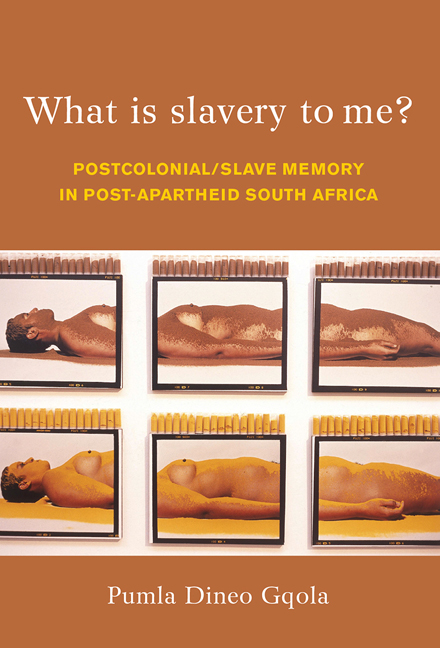Book contents
- Frontmatter
- Contents
- Dedication
- Acknowledgements
- Acronyms
- Introduction: Tracing (re)memory, thinking through echoes of colonial slavery in contemporary South Africa
- 1 Remembering differently: repositioned coloured identities in a democracy
- 2 (Not) Representing Sarah Bartmann
- 3 Whiteness remixed, or remembered impurity, shame and television
- 4 ‘As a slave you have to have faith or you'll give up’: Cape Malay/Muslim identity clusters in Cape Town
- 5 ‘Is the secret in cooking?’ Coded food, spice routes and processing Malay identities
- Conclusion: Unshackling memory, rememorying agency
- Endnotes
- References
- Index
5 - ‘Is the secret in cooking?’ Coded food, spice routes and processing Malay identities
Published online by Cambridge University Press: 21 April 2018
- Frontmatter
- Contents
- Dedication
- Acknowledgements
- Acronyms
- Introduction: Tracing (re)memory, thinking through echoes of colonial slavery in contemporary South Africa
- 1 Remembering differently: repositioned coloured identities in a democracy
- 2 (Not) Representing Sarah Bartmann
- 3 Whiteness remixed, or remembered impurity, shame and television
- 4 ‘As a slave you have to have faith or you'll give up’: Cape Malay/Muslim identity clusters in Cape Town
- 5 ‘Is the secret in cooking?’ Coded food, spice routes and processing Malay identities
- Conclusion: Unshackling memory, rememorying agency
- Endnotes
- References
- Index
Summary
This chapter builds on the discussion on diaspora started in the previous chapter with literary texts and other written narratives. I now turn to analyse Cape Malay/Capetonian Muslim food and Berni Searle's installations as visual sites that individually and collectively encode diasporic slave memory. There are both overlaps with literary embedding previously discussed, and distinct strategies evident in the exploration of diasporic meanings within these two visual texts. In this chapter I am interested in the kind of meanings suggested by visual cultures that are not immediately associated with each other but both of which, nonetheless, receive much public attention. In many respects, these visual texts challenge received notions of how diaspora and slavery are articulated by their location and through chosen framings. Through attention to detail and the interpretative frameworks posited by the communities themselves, in the case of Cape Malay food, more engaged possibilities emerge that are in keeping with the continuum approach evoked in relation to Carolyn Cooper's theorisation in the previous chapter.
Viewing the Malay diaspora through different artistic channels illuminates the territory of diasporic articulation. Olu Oguibe and Okwui Enwezor (1999) have invited a commitment to reading ‘contemporary African visual cultures’ without privileging appraisals that focus on ‘the construction and contestation of identities; identities fashioned by others and foisted on Africans; identities contested and rejected by Africans’ at the expense of ‘African perspectives on the question of identity, and on the parameters of cultural narration’ (1999: 12). Mindful of the vast literature on diaspora and slavery in creative forms, I am nonetheless concerned here with excavating the kinds of meanings that are directly suggested by the visual cultures under analysis, and in answering the question: how do the texts theorise?
Similarly, Gabeba Baderoon (2002: 4) asks: ‘[i]s the secret in cooking? In recipes, shared or hoarded? Or do the secrets of food lie beyond taste?’ Here, she gestures to the connections between food and political processes, subjected to much academic scrutiny in recent years.
Information
- Type
- Chapter
- Information
- What is Slavery to Me?Postcolonial/Slave Memory In Post-Apartheid South Africa, pp. 165 - 200Publisher: Wits University PressPrint publication year: 2010
